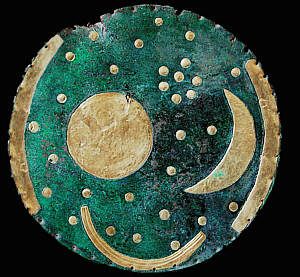Nebra sky disk
The Nebra sky disk is a bronze disk of around 30 cm diameter and a weight of 2.2 kg, with a blue-green patina and inlaid with gold symbols. These are interpreted generally as a sun or full moon, a lunar crescent, and stars (including a cluster interpreted as the Pleiades). Two golden arcs along the sides, marking the angle between the solstices, were added later. A final addition was another arc at the bottom surrounded with multiple strokes (of uncertain meaning, variously interpreted as a Solar Barge with numerous oars, as the Milky Way, or as a rainbow).
The disk is attributed to a site near Nebra, Saxony-Anhalt, in Germany, and associatively dated to c. 1600 BC. It has been associated with the Bronze Age Unetice culture.
The disk is unlike any known artistic style from the period, and was initially suspected of being a forgery, but is now widely accepted as authentic.
The Nebra sky disk features the oldest concrete depiction of the cosmos worldwide. In June 2013 it was included in the UNESCO's Memory of the World Register and termed "one of the most important archaeological finds of the 20th century."
**************************************************
It should be noted that the disk, although a part of "German history," is also a part of "Proto-European history." Whomever constructed it was probably not Teutonic, but rather a Proto-European ancestor of modern Germans; and would also tie into the larger ethnic stock of that time period. If you click the above link, there are images of what appear to be beautiful ceremonial bronze swords which were found with the disk. This would all seem to tie into Proto-European spirituality, and the disk is just as important and relevant a clue as was the Venus of Willendorf.
I believe that from about 1000 BCE and clear back 30,000 years or more, this could be seen as basically the culture of one particular stock of people. That would include certain very ancient modern survivals, such as the Welsh, the Basques, or the Camunians. That would include archaeological finds, such as megalithic temples of Malta, Stonehenge, or Göbekli Tepe in what is now Turkey. This was a culture, as with other civilizations, in which science and spirituality were "one." In other words, the truths regarding nature, the earth, and sky were regarded as sacred. Today, we have the closed-minded science vs. closed-minded religion Hegelian dialectic forming a permanent road block to genuine truth.
At one point the cultural offshoots of this Proto-European stock, very different than anything we could recognize as the "nations" of modern times, lived south of the mile-high sheet of ice which covered most of the British Isles and about one-third of France, Germany, and Poland. Most likely they also inhabited the land which is today known as the Maghrib. This ethnic type was neither Teutonic nor Mediterranean.
.


No comments:
Post a Comment